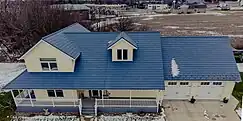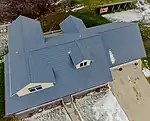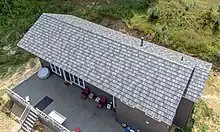



Rubber shingle roofs are a roof system made from recycled rubber typically EPDM or TPO rubber. The rubber shingle can emulate shake or slate in appearance.[1]
History
Rubber roofing shingles have been around since the 1960s but became more popular during the 1970's when asphalt shingles became expensive and in short supply during the oil embargo, with the high petroleum content in the product, making them expensive during the era.
Advantages
High wind rating
Rubber shingles have a high wind rating and can withstand wind speeds of up to 160 mph.[2]
Durability
The rubber material is impact resistant and can withstand large size hail and impacts from falling debris. It can also withstand very high and low temperatures. Resistant to rotting, cracking, mold, discoloration, and denting. Most rubber shingle manufactures have a 30 year warranty.[3]
Fire and lightning resistant
Rubber shingles are Fire resistant and lightning resistant which can lower house insurance if the house insurer is aware of the installation.
Longevity
Rubber roofs can last 50+ years.[4]
Environmentally friendly
Rubber roofs are good insulators and sun reflectors which can lower utility bills. The rubber material is made from recycled material, primarily tires, and is 100% recyclable after its end of lifespan. 13 million tons Of asphalt shingles end up in landfills every year in the United States or about 107 billion individual shingles annually and aren’t nearly as recyclable as rubber shingles.[5]
Sound insulator
Rubber shingles are thicker than most roofs and absorb and deaden sounds better than other roof types.
Lower pitched roofs
With the high wind rating, the pitch of the roof can be lower, allowing less lumber and building material to be used in the roof structure, saving costs. Requiring a pitch of over 10 degrees or featuring two slopes that meet at a central ridge, pitched roofs are known for their classical appearance and effectiveness in wet and cold climates, providing optimal protection against wind and precipitation.[6]
Disadvantages
In some markets color variation may be limited.
See also
References
- ↑ Guild, Roofers (October 13, 2020). "The Pros & Cons of Rubber Roofing (Updated for 2023)".
- ↑ "Rubber Roofing - Rubber roof tiles pros and cons | Rubber shingles". February 1, 2021.
- ↑ "Rubber Roofing Shingles | 2023 Cost Guide". Modernize.
- ↑ https://www.rubberroofingdirect.co.uk/how-long-will-an-epdm-rubber-roof-last#:~:text=If%20installed%20correctly%2C%20you%20can,as%20rain%20and%20strong%20winds.
- ↑ Simmons, Chris (April 17, 2023). "Visualizing Waste: How Many Tons of Asphalt Shingles End Up in Landfills Annually?".
- ↑ "What is a Pitched Roof?". Qualified Roofers. 2023-11-24. Retrieved 2024-01-03.